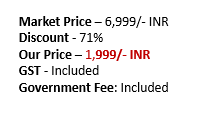- Home
- Income Tax
- GST
- Registration
- Sole Proprietorship Registration
- Section 8 Company
- Partnership Firm Registration
- Nidhi Company Registration
- Private Limited Company Registration
- Trust Registration
- One Person Company Registration (OPC)
- Hindu Undivided Family (HUF)
- Limited Liability Partnership (LLP)
- PF Registration
- Professional Tax
- Digital Signature
- FSSAI Registration
- TAN Application
- Import Export Code (IEC)
- PAN Application
- MSME Registration
- Start Up India Registration
- Professional Tax
- Accounting
- Blog
- Basic
Enquire Us
Expert Guidance And Support In Handling Tax Notices From Tax Authorities
ITR-4 is an income tax return form that is used by taxpayers who are eligible to file their tax returns using the presumptive taxation scheme under section 44AD, 44ADA, or 44AE of the Income Tax Act.
The presumptive taxation scheme is available for certain categories of taxpayers such as individuals, HUFs (Hindu Undivided Families), and partnerships that have a total turnover of up to Rs. 2 crore in a financial year. Under this scheme, the taxpayers are not required to maintain detailed books of accounts and can pay taxes on a presumptive basis.
Here are some key features of the ITR-4 form:
- Eligibility: The ITR-4 form is applicable for individuals, HUFs, and firms (other than LLP) who have opted for the presumptive taxation scheme under sections 44AD, 44ADA, or 44AE of the Income Tax Act.
- Sections Covered: The ITR-4 form includes various sections such as Part-A, Part B, Part C, Part D, Part E, and Part F. Each part requires the taxpayer to provide different types of information such as personal details, income details, deductions, tax payable, etc.
- Mode of Filing: The ITR-4 form can be filed either online or offline. If the taxpayer’s total income exceeds Rs. 5 lahks or if the taxpayer is claiming a refund, then the return must be filed online.
- Documents Required: The taxpayer is required to keep certain documents handy while filing the ITR-4 form such as Form 16, Form 26AS, Profit and Loss Account, Balance Sheet, and other supporting documents.
- Due Date: The due date for filing the ITR-4 form is generally July 31st of the assessment year. However, for FY 2021-22, the due date has been extended to December 31st, 2022.
- Penalties: Failure to file the ITR-4 form on time can result in penalties and interest charges. The penalty for late filing is Rs. 5,000 if the return is filed after the due date but before December 31st of the assessment year. If the return is filed after December 31st, the penalty can go up to Rs. 10,000.
In summary, ITR-4 is an income tax return form that is used by taxpayers who have opted for the presumptive taxation scheme under sections 44AD, 44ADA, or 44AE of the Income Tax Act. The form includes various sections that require the taxpayer to provide different types of information related to income, deductions, tax payable, etc. It can be filed either online or offline, and penalties are levied for late filing.
The following are the key documents that are required for filing the ITR-4 form:
- PAN card: The Permanent Account Number (PAN) card is mandatory for filing the ITR-4 form.
- Aadhaar Card: The Aadhaar card is required to link with the PAN card as per the government’s directive. It is mandatory to provide the Aadhaar card details while filing the ITR-4 form.
- Bank statement: A copy of the bank statement is required to calculate the interest earned on savings accounts and fixed deposits. The statement should reflect the details of all transactions for the financial year.
- Form 16: Form 16 is a certificate issued by the employer to the employee containing details of salary, tax deducted, etc. It is required for salaried individuals to file their ITR-4.
- Form 26AS: Form 26AS is a consolidated tax statement that contains details of tax deducted at source (TDS), advance tax, self-assessment tax, etc. It is available online on the Income Tax Department’s website and is required to cross-check the TDS details while filing the ITR-4 form.
- Profit and Loss Account: This is a statement that shows the revenue earned and expenses incurred by the business during the financial year. It is required for individuals who have opted for the presumptive taxation scheme under section 44AD or 44ADA.
- Balance Sheet: The balance sheet shows the assets, liabilities, and equity of the business at the end of the financial year. It is also required for individuals who have opted for the presumptive taxation scheme under section 44AD or 44ADA.
Apart from the above documents, any other supporting documents like rent receipts, medical bills, education loan certificates, etc., should also be kept handy while filing the ITR-4 form.
Components of ITR 4 Form
ITR-4 form comprises several components that require the taxpayer to provide various details such as personal information, income details, deductions, tax computation, and other additional information related to the taxpayer’s assets and liabilities.
ITR-4 form is divided into various parts that require the taxpayer to provide different types of information. The components of the ITR-4 form are as follows:
Part-A: General Information
- This part requires the taxpayer to provide their personal details such as name, address, PAN, date of birth, email address, etc.
Part-B: Gross Total Income
- This part requires the taxpayer to provide the details of their gross total income from various sources such as salary, house property, business/profession, capital gains, other sources, etc.
Part-C: Deductions and Total Taxable Income
- This part requires the taxpayer to provide details of deductions under various sections of the Income Tax Act such as sections 80C, 80D, 80G, etc., and compute the total taxable income.
Part-D: Tax Computation and Tax Payable
- This part requires the taxpayer to calculate their tax liability based on their total taxable income and the applicable tax rates.
Part-E: Other Information
- This part requires the taxpayer to provide additional information such as details of any foreign assets or income, details of tax deducted at source, etc.
Part-F: Schedule BP
- This part requires taxpayers who are engaged in business or profession to provide details of their business income, expenses, and other related information.
Schedule AL: Assets and Liabilities at the End of the Year
- This schedule requires the taxpayer to provide details of their assets and liabilities at the end of the financial year.
Verification
- The taxpayer must sign and verify the ITR-4 form to confirm the accuracy of the information provided.
Annexure
- The annexure contains details of the tax payable and the tax paid.
Related Guides
Documents Required
- Rental Agreement, if any
- Proof of Rental Income if any
- Proof of Investments to claim Tax Exemption
- Form 26AS
- Monthly Sales Bill
- Sales Return Details
- Tax Paid Challans for GST
- Fixed Assets Invoice Copy (if Applicable)
- Investment details made by Cash
- Investment details made through Bank
- Outstanding receivables and payables
- Bank Statement
- The break-up of Bank Statement
- Loan Details from the bank
- Proof of Foreign Income (if applicable)
- Details of Foreign Assets (if applicable)

